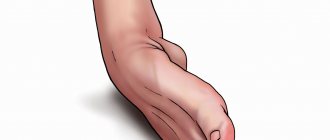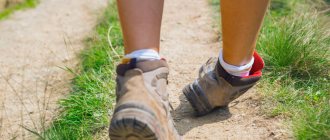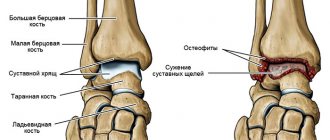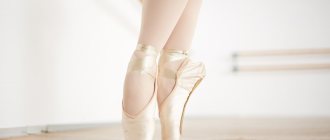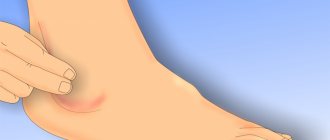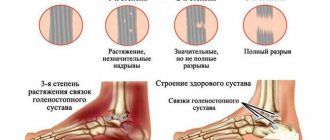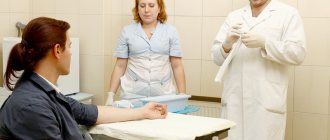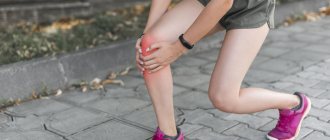Ligaments connect the tissues of joints and bones and consist of connective fibers. Despite their elasticity and strength, they can suddenly become damaged as a result of injury. This is fraught not only with stretching, but also with partial or complete rupture. A minor sprain can be cured on your own, but in case of ruptures you should definitely visit a doctor. Considering that after an injury it is difficult for a lay person to understand how serious the injury is, it is advisable to immediately go to the emergency room and undergo an examination.
A sprain is not considered a serious injury, and proper care will ensure a quick recovery without complications. But if you underestimate the seriousness of the injury and do not provide timely first aid for a sprained ligament, complications may occur. You can understand that the measures taken are not enough by the following symptoms that appear in the first 3 days:
- the temperature has increased;
- the pain increases;
- restriction of mobility persists or increases;
- swelling and redness of the skin appears.
The listed symptoms are a reason to urgently consult a doctor!
Description of ankle ligament injury
One of the most common injuries affecting the modern population is ankle ligament damage. Moreover, in 12% of cases this is due to the presence of tears, tears and sprains in the ankle area. Dislocations or subluxations in the above zone can also provoke a violation of the integrity of the ligamentous apparatus.
Most often, injury to the ankle ligaments occurs during cold periods, when a person overcomes icy surfaces. Often, the cause of such damage can be moving on uneven terrain or jumping from a height.
CLASSIFICATION
The disease can be distinguished by location and type:
- Sprained ligaments of the foot (ankle) - occurs from any sudden movement. In mild cases, it does not require contacting a surgeon.
- Sprain of the knee joint - occurs after a direct blow or fall. The pain occurs immediately, then passes and appears when trying to make a movement. Accompanied by swelling and poor joint mobility.
- Sprain of the sacral ligament - appears due to sharp twisting of the hip, more often occurs in athletes (football).
- Sprain of the acromioclavicular and sternoclavicular ligaments - occurs after a fall on a straight arm or injury to the upper shoulder. Accompanied by severe pain and the inability to raise your arm.
- Shoulder sprain - occurs when a fall or blow to the shoulder area occurs.
- Sprains of the arm (hand) – the wrist is most often damaged. In children, injuries occur due to a sharp blow or jerk with the hand. In adults - as a result of injury.
- Neck sprains are rare and are mostly due to rapid movement of the neck or awkward positioning during sleep.
First aid for ankle ligament injuries
Sometimes an ankle sprain is compared with injuries resulting from a twisted foot. However, in this case it is wrong to talk about a sprain, since bruising and swelling occur. At the time of injury, tears occur in the area of the ligamentous apparatus. In turn, when stretched, the integrity of some fibers is disrupted, but the functional characteristics remain unchanged.
If signs of injury are detected in the ankle area, the person should receive immediate assistance. First of all, it is necessary to minimize the load on the ankle joint. This will prevent deterioration of the ligaments and tendons in the future. The following measures should also be applied to the victim:
- Apply a cold compress. This will make it possible to prevent increased swelling and the spread of bruising to nearby tissues. In this case, the patient notes a loss of sensitivity in the affected area, which helps eliminate pain. Moreover, by using a cold compress immediately after injury, it is possible to reduce the duration of the treatment process. Apply the bandage to the painful area for 20 minutes;
- Using an elastic bandage. To ensure immobility of the damaged joint, it is recommended to use a fixing bandage. Experts recommend avoiding tight bandaging, as it can cause loss of sensation in the fingers and increased swelling. However, such a bandage will prevent the occurrence of ruptures in the future;
- Placing the leg in an elevated position. The injured limb should be placed on pillows or on a chair (in a sitting position). This will relieve pain in the ankle joint and eliminate swelling in nearby tissues.
The use of warming agents is strictly prohibited during the period of first aid. It is not recommended to do alcohol rubbing and take a hot shower. It should be remembered that the fixing bandages are removed before resting at night.
Advice from traumatologists
Sprains often occur in athletes, so their first aid kit is constantly stocked with tools to eliminate pain, immobilize the joint and speed up recovery. Traumatologists recommend that all people replenish their first aid kit with special medical products that may be useful in case of injury.
Self-fixing elastic sprain bandage is an excellent solution for treating damaged tendons. The product is made from fabric of a special structure and does not contain latex (only polyamide, cotton and viscose). All that remains is to choose the appropriate width of the bandage and always have it at hand. Unlike conventional elastic bandages, new medical dressings are resistant to sterilization, X-ray treatment, high temperatures (can be ironed), allow air to pass through and remove moisture from the skin.
Traumatologists recommend not only athletes, but also all active people to buy a self-fixing modern bandage. The costs will be repaid by its long service life - even with repeated use, the material retains its shape. In case of sprained ligaments, this bandage will help out both an adult, a child, and an elderly person.
Treatment of grade 1–2 ankle ligament damage
As a rule, with a slight injury to the ligamentous apparatus, the patient does not notice any signs of the disease. In the first days, the pain syndrome does not make itself felt even with increased physical activity.
Increased swelling, expansion of the bruise area and an increase in the focus of inflammation are observed in the next day. The patient begins to limp, guided by the desire to eliminate discomfort.
Signs of a grade 2 ankle sprain make themselves felt immediately after injury and are accompanied by intense pain. The appearance of bruising and swelling is monitored approximately 60 minutes after the incident. To eliminate the possibility of a violation of the integrity of the ankle, you should immediately contact a traumatologist.
If a patient is diagnosed with a grade 1-2 ankle sprain, treatment does not require hospitalization. In the first 48-72 hours after injury, it is recommended to apply a fixing bandage and a cold compress:
- It is advisable to use an elastic bandage of medium stretch for 2 weeks;
- A bandage made using plaster should not be worn for more than 7 days. Otherwise, it will be difficult to restore muscle tone.
Non-steroidal anti-inflammatory drugs are considered the most effective drugs when the ankle ligaments are damaged. You can also treat ankle ligaments with special gels and ointments: Diclofenac, Ketorolac, Nimesulide, Indomethacin, etc. Such products are intended exclusively for external use, but they can have a powerful analgesic and anti-inflammatory effect.
The doctor may also prescribe ointments to restore blood flow. These include Lyoton gel and Heparin ointment. Thanks to their use, it is possible to improve blood microcirculation and provide active nutrition of the ligaments with important biological and nutrients.
Physical therapy: basic principles of exercises
You can start physical therapy only with the permission of a traumatologist. In some cases, simple exercises can be performed as early as 3 days after the injury, but active training begins approximately a month after the injury. Exercises are selected by the instructor taking into account the nature and extent of the injury. The goal is to improve blood circulation, strengthen muscles and ligaments. If pain occurs during class, the exercises are stopped and transferred to the next day. Exercise cannot be completely excluded from rehabilitation: muscles and ligaments will be replaced by connective tissue, which will limit their mobility.
Stretching is a vital part of physical therapy. It is necessary to avoid spasms of injured muscles and ligaments. As a rule, the exercise lasts 15 seconds, and you need to repeat it 2-3 times a day. For chronic injuries, the duration of stretching is increased to 30 seconds, and the number of repetitions is increased to 3-5 times per day. If you do everything correctly, you will not feel pain the next day. If discomfort occurs, this indicates muscle overstrain, and the intensity of stretching is reduced.
Help with grade 3 ankle sprains
More serious injuries may result in complete rupture of the ankle ligaments. In this case, signs identical to a bone fracture appear. The patient loses the ability to move because he feels severe pain and the inability to step on a limb. Such symptoms are caused by changes in the anatomical relationship of the component parts of the joint. Characteristic features of the disease also include the rapid spread of hematoma and swelling over the entire area of the ankle.
In case of rupture of the ankle ligaments, conservative treatment is practically not prescribed, which is due to the following points:
- There is a weak ability of damaged fibers to fuse;
- It may not be possible to fully restore the functional characteristics of the foot;
- If surgical intervention is refused, there is a risk of recurrent ankle injury due to ankle instability.
Planned surgical intervention is performed in case of complete separation of the ligament from the bone. To restore its continuity, bone and tendon sutures are applied. After completion of the surgical procedure, the patient is recommended to wear a bandage made of plaster for 21-28 days. During the entire rehabilitation period, the patient must take medications that improve blood supply to the tissues in the ankle joint. Medicines that expand the vascular lumens are also prescribed: Venarus, Detralex and Phlebodia.
Make an appointment Online booking
- Clinic on Krasnopresnenskaya +7 (499) 252-41-35 Volkov lane, 21
- Clinic on Varshavskaya +7 (499) 610-02-09 Varshavskoe highway, 75, building 1
- Clinic in Annino +7 (495) 388-08-08 Varshavskoe highway, 154, building 1
Physiotherapy for ankle ligament injuries
For those wondering how to treat an ankle sprain, undergoing physical therapy is a must step. When implementing such measures, you can get a more tangible positive effect than after taking medications.
In case of first and second degree injuries, physiotherapy should be resorted to within 72 hours after the start of treatment. They can also be performed after surgery, during the rehabilitation period. An experienced specialist will help you choose the most effective physiotherapy procedures. At the same time, he takes into account the individual nuances of each patient, as well as:
- Intensity of damage;
- The ability of tissues to regenerate;
- Presence in the anamnesis of pathologies caused by malfunctions of the cardiovascular system.
Initially, the patient is recommended to undergo a procedure that involves exposure to direct electric current and special medications. For this purpose, a cotton swab soaked in a special medicine is applied to the damaged area, and metal plates are placed on it. By using electrical impulses, the medicine can reach the deepest layers of tissue. As a rule, during the procedure, agents with analgesic and anti-inflammatory effects are used. In some situations, to speed up the process of fusion of ligaments that were previously torn from the base, it is recommended to use chondroprotectors.
Also during the recovery period, the following techniques can be used: ultrasound exposure, paraffin baths, magnetic therapy and shockwave therapy.
Treatment of ankle ligaments with shock wave therapy
The best effect in restoring the ankle joint can be achieved using the shock wave method. It is based on the influence of acoustic waves, which ensures rapid regeneration processes:
- Hematomas disappear;
- Ensures active crushing of calcium deposits and destruction of connective tissue cords (scars);
- Blood flow improves;
- Metabolic processes are accelerated.
However, in order to achieve a better result when restoring the deltoid ligament of the ankle joint, an integrated approach should be provided - combining the UVS technique with the use of medications. This will allow you to quickly cope with pain when moving, eliminate swelling and improve the motor activity of the joint.
According to most patients, it is possible to obtain noticeable improvements after shock wave therapy after the first sessions. Lost lightness returns, the feeling of stiffness and discomfort goes away, and overall well-being improves.
In our clinic, the SWT procedure is performed by orthopedic doctors with extensive experience, who have the skills to work with special equipment and provide a personal approach to each visitor. At the same time, the first visit to our medical center is carried out with a 20% discount.
Exercise therapy to strengthen the ankle joint and ligaments
Physical therapy can also improve the functional activity of ligaments and tendons. The initial step involves a light warm-up. More complex exercises are gradually introduced. The main principle of exercise therapy is the absence of pain. When engaging in physical education, you should adhere to the following rules:
- Complete rest for extended periods of time should be avoided;
- It is necessary to avoid increased stress on the joint.
One of the most effective and mandatory exercises for all patients with this disease is walking on their heels and toes several times a day. Experts also advise performing extension/flexion of the foot, combining them with rotational movements.
In the absence of timely measures for first-degree pathology, serious complications may arise in the future. These include: diseases of the joints of inflammatory etiology, pathological flattening of the foot, dislocations, deforming osteoarthritis.
The medical center employs competent specialists who will provide first aid, perform all the necessary examinations and draw up a treatment plan, the implementation of which will help avoid irreversible consequences in the future. Our clinic performs X-ray examination, ultrasound and surgery. However, the priority and most effective way to restore the ankle joint is shock wave therapy. When implementing this technique, modern Swiss equipment is used, which allows you to get a quick and effective result.
Diagnostics
In addition to the clinical signs that a traumatologist or orthopedist evaluates in person, the following help confirm or refute a sprain:
- X-ray examination of the injured area;
- ultrasound scanning of soft tissues surrounding the joint;
- magnetic resonance or computed tomography, indicated for extensive damage.
MRI or CT is also prescribed if there is a sprain of articular ligaments that are in an awkward position for other examination methods, for example, the meniscus, fibers in the groin area.
How to avoid ankle ligament injuries?
In order to minimize the risk of joint injury, experts recommend adhering to the following measures:
- Ensure sufficient and regular physical activity to maintain the necessary elasticity of the ligaments;
- Provide moderate loads on the limb;
- Use comfortable shoes with low heels (no more than 7 cm);
- Perform a special set of exercises to strengthen the ankle joint and ligaments;
- Try to maintain normal weight;
- Timely treat pathologies that have a negative impact on the musculoskeletal system.
